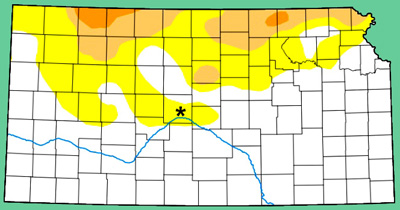
Kansas drought status for June 17, 2025. TNC Cheyenne
Bottoms Preserve (*). From the U.S. Drought Monitor.
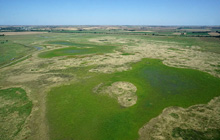 toward Hoisington 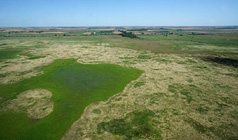 central pool-marsh complex 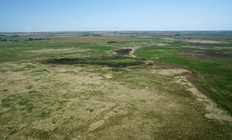 toward Deception Creek |

 toward Hoisington  central pool-marsh complex  toward Deception Creek |
We were surprised to see dense coverage of water smartweed across the damp mudflats and shallow pools. From the bird's-eye view, the smartweed looks like bright-green mats surrounded by pale-yellow foxtail barley that forms a high visual contrast. We have never witnessed this abundant spread of water smartweed before. However, the water smartweed bloom is likely to be short lived, as conditions change during the coming summer.
Other vegetation continues trends seen during the previous drought years—see 2024 vegetation. Various opportunistic and undesirable plants still are present. Foxtail barley covers much of the dry mudflat areas, and poison hemlock occupies slightly higher and drier islands and shoreline settings. Small stands of bulrush, cattail, and musk thistle are present locally, all of which gives rise to a mixture of wetland and dryland vegetation. As with the water smartweed bloom, this assemblage of vegetation is likely to be ephemeral as water levels and soil moisture fluctuate.
In addition, an algal bloom had turned the water green over portions of the pools. The algae did not float in a blanket on the water surface but, rather, was submerged just below the surface. From ground level, the water appeared dark blue, reflecting sky color, but from the kite's-eye view the green color was quite distinct. The color is often described as "pea soup" or like paint dumped in the water. We have not seen an algal bloom of this magnitude before in more than two decades of kite aerial photography at this site.
Cyanobacteria, formerly called blue-green algae, is the mostly likely micro-organism for this situation, although many other types of algae may appear in such blooms. Cyanobacteria is extremely common in nearly all freshwater lakes under natural conditions—see Cyanobacteria. Such algal blooms are enhanced by warm summer weather, still water, exposure to sunlight, and by nutrients, particularly nitrogen and phosphorus. All these conditions are present in the shallow pools. Summer flooding may have washed in nutrients derived from agricultural fields upstream in the Deception Creek watershed.
Autumn 2025 – Deception Creek
We retuned to TNC Cheyenne Bottoms Preserve in mid-October for another round of kite aerial photography (KAP) at the Deception Creek study site. Repeated rains and flooding during the summmer had filled all the pools and sloughs of the wetland complex. Drought conditions had ended completely for western and most of central Kansas, including the Cheyenne Bottoms vicinity. This led, in turn, to major changes in vegetation and the overall appearance of the site. 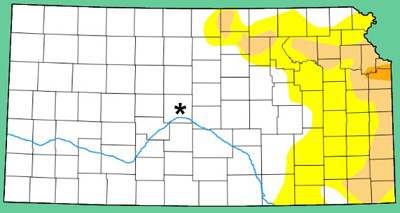
Kansas drought status for Oct. 21, 2025. TNC Cheyenne
Bottoms Preserve (*). From the U.S. Drought Monitor.
![]() Wide-angle KAP overviews
Wide-angle KAP overviews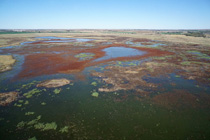
toward Hoisington
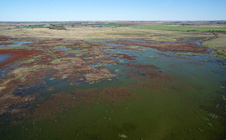
central pool-marsh complex

toward Deception Creek

Left: overview of pools that were covered by water smartweed in June. The reddish-brown vegetation nicely outlines the former extent of water smartweed—compare with June images above.
Right: common reed grass (Phragmites) ground view. It stands in pale-green patches above shallow water, and the dark seed heads are distinctive.

Vegetation blooms
Unexpected blooms of wetland vegetation may take place during transitions following floods or droughts. In fact, two such blooms took place in 2025, namely algae in the autumn and water smartweed in the spring (see above). Another example is mosquito fern, also known as fairy moss or water fern (genus Azolla). Mosquito fern covered much of the marsh-and-pool water surface in the autumn of 2009 (Aber et al. 2010). Following the mosquito-fern bloom, it was nearly absent from TNC marshes during the drought period 2011-13. It appeared once again during the wet interval 2014-2015, but has not been seen since.
A similar bloom of common duckweed (Lemna minor) took place in 2020—see 2020 status. This bloom was encouraged by the removal of cattail via aerial spraying in previous years and the exceptionally wet year in 2019 and continuing high water level. Duckweed resembles split green peas; it's the smallest and simplest of all flowering plants and is also one of the most common plants worldwide. Duckweed is often present during wet periods, but is normally not abundant at this site.
These short-lived blooms indicate the dynamic and highly variable character of wetland ecosystems under the passive management scheme at TNC Cheyenne Bottoms Preserve (Aber, Aber and Penner 2016, 2025). Frequent changes in water levels lead to alternate flooding and drying of marsh-and-pool zones seasonally and year to year. Thus, fleeting environmental conditions may arise. As a result of these cycles, the vegetation is always in a state of flux, and ephemeral plant communities may come and go.
![]() Return to beginning.
Return to beginning.
Return to Cheyenne Bottoms homepage.
All rights reserved © (2025).